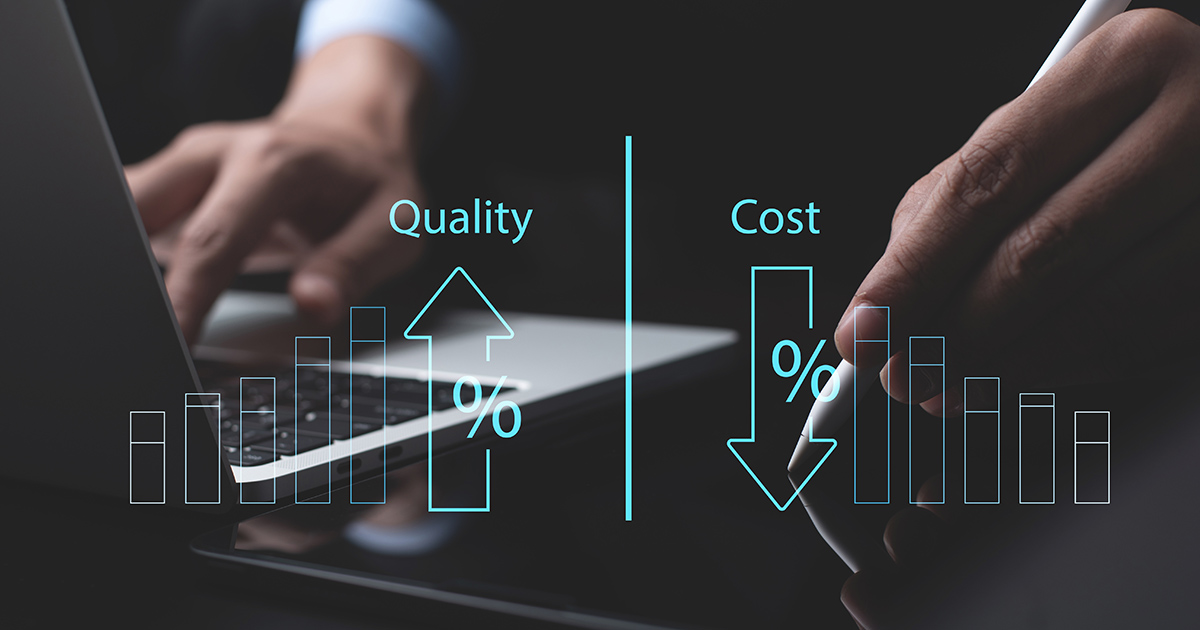Enhancing Product Quality and Reducing Costs: The Relevance of Value Engineering in Today’s Industries
Given the current economic situation, manufacturing companies must implement a variety of tools to increase cost efficiency in order to remain profitable over time. A balancing act must be performed between reducing costs and maintaining product and service quality at the same time. The principle of Value Engineering proves to be a promising approach to achieving the necessary balance.
The following article outlines the basics of Value Engineering and explains how it contributes to both reducing costs and improving products and services.

What is Value Engineering?
Value Engineering is a systematic organized procedural decision-making process. It aims to optimize the balance between cost, reliability, performance, and quality. Originating as a cost-reduction technique, VE has evolved to focus on maximizing the value of a product or service by examining its function and seeking cost-effective alternatives that do not compromise quality. It is a holistic approach that involves a thorough analysis of the materials, processes, and design aspects of a product, ensuring that every component delivers maximum value for the least possible cost.
The concept of Value Engineering took root during World War II, primarily due to material and component shortages. Lawrence Miles and Harry Erlicher at General Electric are credited with its conception, as they sought alternatives that reduced cost without sacrificing performance. Initially applied in manufacturing, VE has since permeated various sectors, evolving in its application and scope. Its evolution reflects a shift from a purely cost-saving exercise to a broader focus on enhancing value, encompassing aspects like environmental sustainability and user experience, making it a versatile tool in modern business strategies.
Principles of Value Engineering
The fundamental principles of Value Engineering lie in its rigorous, multidisciplinary examination of the factors that define a product or service's value. This process involves a detailed analysis of the functions of an item, understanding how each component contributes to the overall performance and cost. The goal is to identify and eliminate unnecessary expenditures, thereby maximizing the value for both the manufacturer and the customer.
While often confused with mere cost-cutting, Value Engineering significantly differs in its approach and outcome. Cost cutting primarily focuses on reducing expenses, which can sometimes lead to a compromise in quality or functionality. In contrast, Value Engineering aims to maintain or enhance the quality and functionality of a product while reducing costs. This strategic approach involves a more profound understanding of the product’s purpose and seeks innovative ways to achieve the desired outcome more efficiently, without compromising the end user's needs and expectations.
Key Components of Value Engineering: Function, Cost, and Value
The core of Value Engineering consists of three key components: function, cost, and value. 'Function' refers to what the product or service is supposed to do, the 'cost' relates to the expenses incurred in providing the function, and 'value' is the ratio of function to cost. Value can be increased by either improving the function or reducing the cost. The crux of VE is to strike the right balance between these elements, ensuring the maximum value for the least possible cost. This balance is critical for businesses aiming to stay competitive and profitable in a market where customer expectations and economic pressures are constantly evolving.
The Process of Value Engineering in Detail
The Value Engineering process is characterized by five distinct phases: Information, Speculation, Evaluation, Development, and Presentation. Each phase plays a critical role in ensuring that the Value Engineering approach not only enhances functionality but also reduces costs.
Information Phase: Gathering and Analysing Data
The information phase is the bedrock of the Value Engineering process. In this phase, teams gather and scrutinize data to fully understand the product, process, or service under review. This involves analysing functions, costs, and performance metrics. The objective is to develop a comprehensive understanding of the existing conditions and constraints. By dissecting the 'what' and 'why' of the current state, teams can identify areas ripe for improvement, setting the stage for innovative thinking and value enhancement.
Speculation Phase: Generating Ideas
During the speculation phase, the focus shifts to creative and out-of-the-box thinking. Teams brainstorm a wide range of ideas, encouraged to think without constraints to foster innovation. This phase is not about evaluating ideas for practicality but about generating as many solutions as possible. It's a divergent process where quantity is valued over quality, believing that within the multitude of ideas lie the seeds of feasible, cost-effective solutions that can enhance value significantly.
Evaluation Phase: Assessing Ideas for Feasibility and Cost-Effectiveness
The evaluation phase is where the ideas generated during the speculation phase are critically analysed for feasibility and cost-effectiveness. This is a convergent process, where the multitude of ideas are sifted to identify the most promising ones. The evaluation criteria often include factors like practicality, cost implications, and the potential to enhance value. This phase is crucial in ensuring that only those ideas that align with the objectives of cost reduction and functionality enhancement move forward.
Development Phase: Turning Ideas into Practical Solutions
In the development phase, the selected ideas are transformed into workable solutions. This involves detailed planning, design, and testing. Teams work on refining the ideas, addressing technicalities, and ensuring that the solutions are not only feasible but also cost-effective. This phase often involves prototypes or models to demonstrate how the idea will work in practice. It's a critical bridge between theoretical solutions and practical applications, ensuring that the value-added proposition is both viable and sustainable.
Presentation Phase: Documenting and Presenting the Value-Added Solution
The final phase, the presentation phase, is about documenting and communicating the value-engineered solution. This involves preparing detailed reports and presentations that outline the process, the solution, and the expected benefits. The aim is to clearly demonstrate how the solution enhances functionality while reducing costs. This phase is essential for gaining stakeholder buy-in, whether it be for internal approvals or convincing clients. A well-documented and presented solution can effectively showcase the innovation and effort involved, highlighting the tangible and intangible benefits of Value Engineering.
The Benefits of Implementing Value Engineering
Value Engineering is not just a cost-cutting exercise; it's a systematic method that enhances overall value. In today's competitive business landscape, implementing VE is essential for organizations seeking to optimize resources while maintaining or improving quality and performance.
Cost Reduction and Optimization
One of the most tangible benefits of Value Engineering is cost reduction and optimization. Through this approach, businesses can scrutinize their processes, materials, and design methodologies to identify and eliminate unnecessary expenditures. VE doesn't simply trim expenses; it streamlines operations, ensuring that every resource contributes to its maximum potential. This strategic reduction and optimization of costs can significantly enhance a company's financial health and competitive edge, making it more agile and responsive to market changes.
Improvement in Quality and Performance
Contrary to the misconception that cost-cutting compromises quality, Value Engineering often leads to an improvement in both quality and performance. By re-evaluating each element of a product or process, businesses can discover innovative ways to enhance functionality, durability, and user experience. This focus on optimizing value rather than just reducing costs ensures that the end product is not only more cost-effective but also of higher quality, meeting or exceeding customer expectations.
Enhanced Stakeholder Satisfaction
Value Engineering extends its benefits beyond the company’s balance sheet to encompass enhanced stakeholder satisfaction. This holistic approach takes into account the needs and expectations of all stakeholders, including customers, employees, suppliers, and shareholders. By delivering products and services that offer greater value, businesses can improve customer loyalty and market reputation. Similarly, internal stakeholders benefit from streamlined processes and a culture that values efficiency and innovation, contributing to a more dynamic and satisfying work environment.
Fostering Innovation and Creativity
Value Engineering is a powerful catalyst for innovation and creativity within an organization. It challenges teams to think differently, questioning the status quo and encouraging out-of-the-box thinking. This environment is conducive to generating novel ideas and solutions, fostering a culture of continuous improvement and innovation. By embedding these principles into the organizational ethos, businesses can stay ahead of the curve, adapting quickly to new challenges and opportunities in their respective industries.
Conclusion: The Transformative Impact of Value Engineering
Value Engineering has emerged as a key strategic asset in modern industries, transcending its traditional role as a mere cost-cutting tool. It focuses on maximizing the value of products or services by balancing functionality and cost, ensuring efficient and purposeful design at minimal expense. This approach yields multiple benefits, including significant cost savings, enhanced product quality, increased customer satisfaction, and improved market competitiveness.
In the context of a rapidly changing global economy with evolving technological advancements, Value Engineering is particularly critical. It aligns cost optimization with value creation, which is essential for businesses to maintain competitiveness and sustainability.
Value Engineering is not just a methodology; it's a mindset that prioritizes efficiency, innovation, and value creation. Its principles are increasingly vital for businesses aiming to thrive in the future. Overall, Value Engineering is a comprehensive strategy for business excellence, crucial for economic efficiency, innovative growth, and sustained market relevance.

Value Engineering with 4cost
The software and service solutions from 4cost provide you with a maximum of cost transparency at all phases. For improved cost control and increased profitability.
Request a commitment-free presentation now. Our experts will be happy to advise you on the right solutions for your company.

